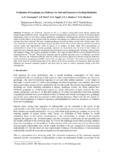Evaluation of Geophagia as a Pathway for Internal Exposure to Ionizing Radiation

View/
Date
2015Author
Mustapha, AO
Patel, JP
Ngigi, EN
Rathore, IVS
Hashim, NO
Language
enMetadata
Show full item recordAbstract
Geophagia, the deliberate ingestion of soil, is a complex eating habit found among animals and human beings around the world. Among other reasons soil ingestion is perceived as a source of essential mineral supplements, hence its prevalence among subsistence communities. Geophagia has also been associated with a range of health effects. In the present study the potential of geophagia as a pathway for chronic internal radiation exposure has been evaluated. The most common geophagic materials in Kenya are the soft volcanic ashes. They occur naturally in various hues and shades of grey and pink colours. The volcanic ashes are quarried and sold in various kiosks and supermarkets either in pieces or in packets of about 100g. The concentrations of radionuclides in some of the common geophagic materials are determined, and the rates of their intakes (by ingestion) were estimated using the information obtained from a survey among people, including young mothers and pregnant women, who practice geophagia in Kenya. The range of annual effective doses estimated from the concentrations of 228Th and 226Ra in these materials, and the possible ingestion rates (1 to 90g/day), are below 1mSv. However, the committed effective dose for a fifty-year chronic ingestion evaluated using the biokinetic model calculation programme (LUDEP version 2.04) are high: up to 276 mSv. The results are discussed in the light of the need for reliable human data on the effects of low-level radiation, also bearing in mind that these materials are essential consumer products and there may be need to control exposures arising from their consumption.
Publisher
University of Nairobi
